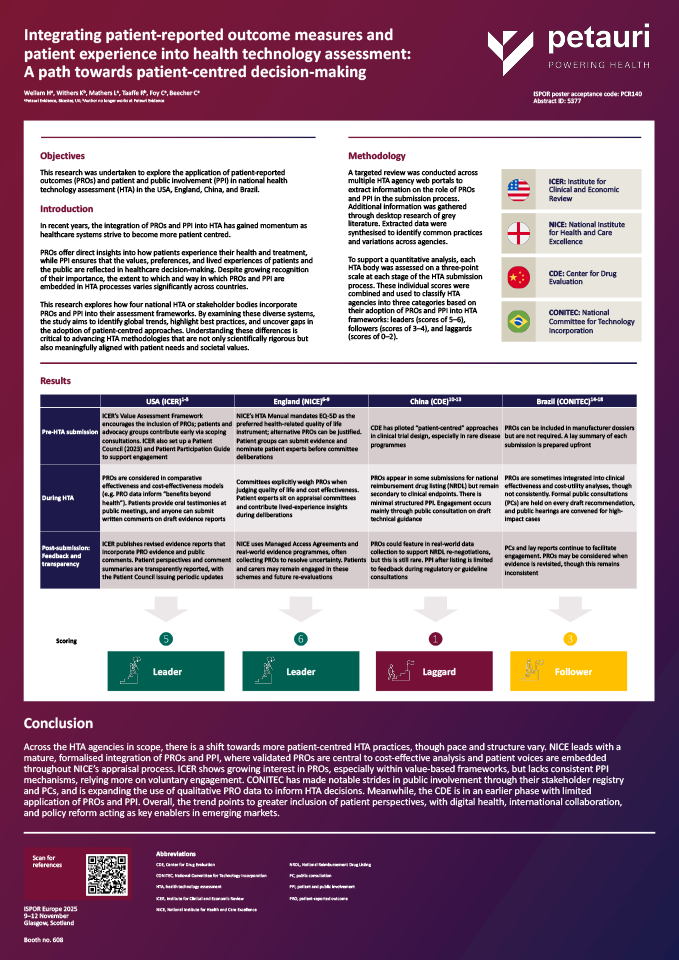Integrating patient-reported outcome measures and patient experience into health technology assessment: A path towards patient-centred decision-making
The Petauri Evidence team will be presenting this research at ISPOR Europe in Glasgow, in Poster Session 5 on Wednesday 12th November.
View referencesPoster introduction:
Objectives:
This research was undertaken to explore the application of patient-reported outcomes (PROs) and patient and public involvement (PPI) in national health technology assessment (HTA) in the USA, England, China, and Brazil.
Introduction:
In recent years, the integration of PROs and PPI into HTA has gained momentum as healthcare systems strive to become more patient centred.
PROs offer direct insights into how patients experience their health and treatment, while PPI ensures that the values, preferences, and lived experiences of patients and the public are reflected in healthcare decision-making. Despite growing recognition of their importance, the extent to which and way in which PROs and PPI are embedded in HTA processes varies significantly across countries.
This research explores how four national HTA or stakeholder bodies incorporate PROs and PPI into their assessment frameworks. By examining these diverse systems, the study aims to identify global trends, highlight best practices, and uncover gaps in the adoption of patient-centred approaches. Understanding these differences is critical to advancing HTA methodologies that are not only scientifically rigorous but also meaningfully aligned with patient needs and societal values.
Please complete the form below to download the full poster:

Back to ISPOR Europe Virtual Booth
To help save the planet and to save you from carrying a tonne of literature around the exhibition hall, all our resources are available virtually.
Poster references:
- ICER. ICER’s New Patient Engagement Program: Amplifying the Patient Voice Before, During, and After a Value Assessment. 2020. Available from: https://icer.org/news-insights/commentaries/icers-new-patient-engagement-program-amplifying-the-patient-voice-before-during-and-after-a-value-assessment/. Accessed: September 2025.
- ICER. ICER Launches a Patient Council to Amplify the Patient Voice in Value Assessment. 2023. Available from: https://icer.org/news-insights/press-releases/icer-launches-a-patient-council-to-amplify-the-patient-voice-in-value-assessment/. Accessed: September 2025.
- ICER. 2024. Available from: https://icer.org/who-we-are/people/icer-patient-council/. Accessed: September 2025.
- ICER. 2023-2024 Patient Council Progress Report. 2024. Available from: https://icer.org/wp-content/uploads/2023/10/ICER_2023_VAF_For-Publication_101723.pdf. Accessed: September 2025.
- ICER. Value Assessment Framework. 2023. Available from: https://icer.org/wp-content/uploads/2023/09/ICER_2023_VAF_For-Publication_092523.pdf. Accessed: September 2025.
- NICE. Patient involvement in Technology Appraisal: Summary report. N.D. Available from: https://www.nice.org.uk/Media/Default/About/NICE-Communities/Public-involvement/Public-involvement-programme/patient-involvement-ta-process.pdf. Accessed: September 2025.
- NICE. Patient and public involvement policy. 2013. Available from: https://www.nice.org.uk/media/default/About/NICE-Communities/Public-involvement/Patient-and-public-involvement-policy/Patient-and-public-involvement-policy-November-2013.pdf. Accessed: September 2025.
- NICE. NICE health technology evaluations: the manual. 2025. Available from: https://www.nice.org.uk/process/pmg36/resources/nice-health-technology-evaluations-the-manual-pdf-72286779244741. Accessed: September 2025.
- NICE. NICE real-world evidence framework. 2022. Available from: https://www.nice.org.uk/corporate/ecd9/resources/nice-realworld-evidence-framework-pdf-1124020816837. Accessed: September 2025.
- iMedia. CDE “Guiding Principles for the Application of Patient Report Outcomes in Drug Clinical Development (Trial)“. 2022. Available from: https://min.news/en/health/c82b12d465a506a814a78d4a27062cba.html. Accessed: September 2025.
- CDE. The Center for Drug Evaluation’s (CDE) draft PRO guidance CDE. N.D. Available from: https://www.cde.org.cn/main/att/download/35f59af313045f983a8f5bebc23507a8. Accessed: September 2025.
- Zhou H, et al. Application of patient-reported outcome measurements in clinical trials in China. JAMA Netw Open. 2022;5(5):e2211644.
- Guo W, et al. Health technology assessment in China’s health care sector: development and applications. Health Syst Reform. 2023;9(3):2327099.
- EuroScan International Network. A toolkit for the identification and assessment of new and emerging health technologies, 2014, EuroScan International Network: Birmingham. Edited by Dr. Sue Simpson, EuroScan Secretariat. Translated into Portuguese by the Department of Management and Incorporation of Technologies and Innovation in Health of the Ministry of Health and invited speakers. October 2019.
- Thokagevistk K, et al. Real-world evidence to reinforce clinical trial evidence in health technology assessment: a critical review of real-world evidence requirements from seven countries and recommendations to improve acceptance. J Mark Access Health Policy. 2024;12(2):105-17.
- INAHTA. 2025. CONITEC – National Committee for Technology Incorporation. N.D. Available from: https://www.inahta.org/members/conitec/. Accessed: September 2025.
- Silva AS, et al. A framework for action to improve patient and publicinvolvement in health technology assessment. Int J Technol Assess HealthCare. 2022;38(1):e8.
- Lopes ACF, Novaes HMD, Soárez PC. Patient and public involvement in health technology decision-making processes in Brazil. Rev Saúde Publica. 2020;54:136.
